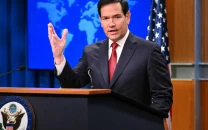Comparing Asean and Saarc
Asean will no longer be prickly with sovereignty issues; it will focus on common trade policy.

Comparing Asean and Saarc
The Association of Southeast Asian Nations (Asean) was founded in 1967 and it has just announced that by 2015 the states included in it will have become a single market like the European Union (EU). Asean already trades 25 per cent within itself, which means it is fairly set to become a regional trading bloc like the EU. One can see what has happened. Like the EU, the nation-state is being transformed to get rid of conflict.
Europe went through two traumas; the religious wars spread over centuries, and the nationalism of the nation-state that led to two world wars and laid the continent waste. The first stage is the conversion of the warrior state to a market state, then its submergence in the regional identity. Starting 2015, Asean will no longer be prickly with sovereignty issues; it will give up foreign policy in favour of a common trade policy. Asean started with founding members Indonesia, Malaysia, the Philippines, Singapore and Thailand; then added Brunei Darussalam, Cambodia, Laos, Myanmar and Vietnam in later years.
The South Asian Association of Regional Cooperation (Saarc) came into being in 1985, with founding members Bangladesh, Bhutan, India, Maldives, Nepal, Pakistan and Sri Lanka. Afghanistan joined in 2007. Both were set up because the members were embroiled in serious disputes. Perhaps Asean was more troubled because of its conglomeration of islands and unclear laws dealing with maritime frontiers. Yet, while Asean was able to avoid conflict, Saarc was not.
What was the reason? Some say Asean was a grouping against an outside threat — communism, while in the case of Saarc the enemy was within — India. Yet, Asean members had serious interstate disputes which they decided to forget. On the other hand, Saarc members insisted that disputes be resolved first, before economic cooperation could start. Asean nations were inclined to be trading nations; Saarc nations were inclined to be warlike. Asean moved to conflict-avoidance mechanisms; Saarc refused to discuss bilateral disputes.
Not discussing disputes did not mean that Saarc gave priority to trade. Asean took no time in agreeing (1997) on two types of free trade areas (Afta) while Saarc made heavy weather of its South Asian Preferential Trade Area (Sapta), signed in 1993. It signed the South Asian Free Trade Area (Safta) in 2004 but added to the agreement Article 14, stating that ‘nothing in this Agreement shall be construed to prevent any Contracting State from taking action and adopting measures which it considers necessary for the protection of its national security’ while leaving some room in the interpretation of what might constitute an issue of national security.
Saarc had to suffer an Indo-Pakistan war at Kargil started by Pakistan in 1999, which prevented three Saarc summits from taking place. India has given Pakistan the most favoured nation status but Pakistan has not reciprocated. In 2008, war loomed again after Mumbai was attacked by a jihadi outfit from Pakistan. Pakistan complains that India is destabilising it; but Pakistan is internationally isolated as it tackles intra-state conflict, its growth rate not matching that of other Saarc members.
Dominated by the army and increasingly vulnerable to passions of national honour inculcated by terrorist groups, Pakistan needs to concentrate on a trade-and-investment regime on a regional basis and also concentrate on improving on the bilateral free trade agreement with India to prevent the security-related restrictions applied by the two on the 2,000-item trade they have allowed so far. India also needs to improve its trade conduct in respect of the non-tariff barriers it applies to what it imports and the concealed subsidy it allows its own products.
Published in The Express Tribune, April 17th, 2011.
Europe went through two traumas; the religious wars spread over centuries, and the nationalism of the nation-state that led to two world wars and laid the continent waste. The first stage is the conversion of the warrior state to a market state, then its submergence in the regional identity. Starting 2015, Asean will no longer be prickly with sovereignty issues; it will give up foreign policy in favour of a common trade policy. Asean started with founding members Indonesia, Malaysia, the Philippines, Singapore and Thailand; then added Brunei Darussalam, Cambodia, Laos, Myanmar and Vietnam in later years.
The South Asian Association of Regional Cooperation (Saarc) came into being in 1985, with founding members Bangladesh, Bhutan, India, Maldives, Nepal, Pakistan and Sri Lanka. Afghanistan joined in 2007. Both were set up because the members were embroiled in serious disputes. Perhaps Asean was more troubled because of its conglomeration of islands and unclear laws dealing with maritime frontiers. Yet, while Asean was able to avoid conflict, Saarc was not.
What was the reason? Some say Asean was a grouping against an outside threat — communism, while in the case of Saarc the enemy was within — India. Yet, Asean members had serious interstate disputes which they decided to forget. On the other hand, Saarc members insisted that disputes be resolved first, before economic cooperation could start. Asean nations were inclined to be trading nations; Saarc nations were inclined to be warlike. Asean moved to conflict-avoidance mechanisms; Saarc refused to discuss bilateral disputes.
Not discussing disputes did not mean that Saarc gave priority to trade. Asean took no time in agreeing (1997) on two types of free trade areas (Afta) while Saarc made heavy weather of its South Asian Preferential Trade Area (Sapta), signed in 1993. It signed the South Asian Free Trade Area (Safta) in 2004 but added to the agreement Article 14, stating that ‘nothing in this Agreement shall be construed to prevent any Contracting State from taking action and adopting measures which it considers necessary for the protection of its national security’ while leaving some room in the interpretation of what might constitute an issue of national security.
Saarc had to suffer an Indo-Pakistan war at Kargil started by Pakistan in 1999, which prevented three Saarc summits from taking place. India has given Pakistan the most favoured nation status but Pakistan has not reciprocated. In 2008, war loomed again after Mumbai was attacked by a jihadi outfit from Pakistan. Pakistan complains that India is destabilising it; but Pakistan is internationally isolated as it tackles intra-state conflict, its growth rate not matching that of other Saarc members.
Dominated by the army and increasingly vulnerable to passions of national honour inculcated by terrorist groups, Pakistan needs to concentrate on a trade-and-investment regime on a regional basis and also concentrate on improving on the bilateral free trade agreement with India to prevent the security-related restrictions applied by the two on the 2,000-item trade they have allowed so far. India also needs to improve its trade conduct in respect of the non-tariff barriers it applies to what it imports and the concealed subsidy it allows its own products.
Published in The Express Tribune, April 17th, 2011.















COMMENTS
Comments are moderated and generally will be posted if they are on-topic and not abusive.
For more information, please see our Comments FAQ